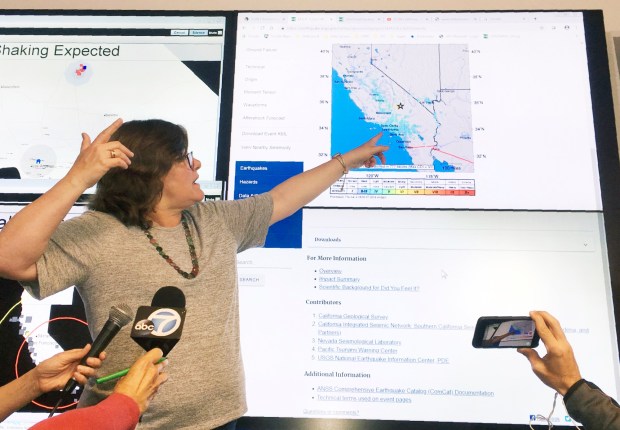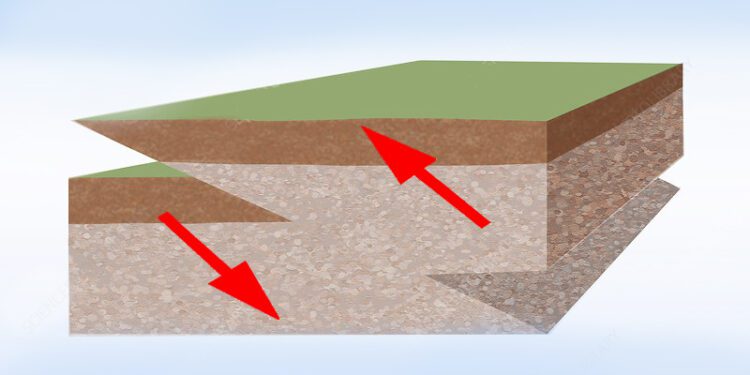The more than 800-mile-long fault system makes Puente Hills seem tiny by comparison. San Andreas stretches from Northern California to Cajon Pass near San Bernardino and includes several branch faults including San Jacinto and Banning, according to a USGS report.
Puente Hills is one of many thrust faults in the Los Angeles Basin, including Elysian Park and Compton thrust faults, according to USGS Research Geologist Dr. Alex Hatem.
Jones noted on social media on Tuesday that 13 earthquakes have rattled Southern California this year with magnitudes of 4.0 or greater.
Historically, there have been about five earthquakes per year of 4.0 or greater in Southern California over the past 20 years. And since 1932, the average number of earthquakes with magnitudes of 4.0 or greater in Southern California is between 10 and 12, Jones posted. The number of earthquakes greater than 4.0 in 2024 is closer to the average recorded in Southern California over the past 90 years.
But even though the region has been shaken by several quakes recently, it hasn’t been a huge surprise to researchers. Despite Monday’s hefty shake, the Puente Hills fault is not showing any unusual activity.
 Seismologist Lucy Jones talks during a news conference at the Caltech Seismological Laboratory in Pasadena, Calif., Thursday, July 4, 2019.(AP Photo/John Antczak)
Seismologist Lucy Jones talks during a news conference at the Caltech Seismological Laboratory in Pasadena, Calif., Thursday, July 4, 2019.(AP Photo/John Antczak)
“The faults of the L.A. Basin are indeed considered active and have been known about for many years,” Hatem said in an email. “We have not detected an increase in earthquakes from this fault.”
Hatem said with every California earthquake there is generally about a 5% chance that it could precede a larger earthquake.
Jones said ground vibrations do not vary much based on the type of earthquake. She compared the motion of a fault to fingers moving together when snapping. What people feel during an earthquake is the equivalent of the sound of a snap.
“Every one of us has active faults nearby. We don’t know which one’s going to go next.” — Dr. Lucy Jones
Those closer to the epicenter of the earthquake will feel more jerky motion, but farther away, as high frequency waves have dissipated, all that’s left are lower-frequency waves that result in the slower rolling motion feel.
While the Puente Hills Fault system is being singled out because of the recent earthquake, Jones said there are hundreds of similar faults all around the region.
Everyone in Southern California lives within five miles of an active fault, she said.
“Every one of us has active faults nearby,” Jones said. “We don’t know which one’s going to go next.”
Hatem said it’s hard to call a smaller earthquake good or bad based on the amount of energy it releases.
The 6.7-magnitude Northridge earthquake released nearly 2,800 times the energy as Monday’s, according to Hatem.
Based on USGS calculations, the 1987 Whittier Narrows quake was 31 times bigger than Monday’s Highland Park earthquake, releasing 177 times more energy.
Whittier Mayor Joe Vinatieri was driving on Monday, so he didn’t feel the earthquake, but hearing the location of the epicenter triggered memories of 1987.
“We always didn’t think that much about it growing up,” Vinatieri said. “We knew there was a fault line right here where we lived, but we found out how active it can be.”
 This replica of Michaelangelo’s statue of David was originally installed at Forest Lawn, until it toppled and broke in the Whittier Narrows earthquake, and was subsequently donated to Cal State Fullerton. (Photo by Bruce Chambers, Orange County Register, 2002)
This replica of Michaelangelo’s statue of David was originally installed at Forest Lawn, until it toppled and broke in the Whittier Narrows earthquake, and was subsequently donated to Cal State Fullerton. (Photo by Bruce Chambers, Orange County Register, 2002)
Just before 8 a.m. the morning of the earthquake, Vinatieri was in a fifth-floor office when it struck. He said it started slow and became more and more intense. Vinatieri described those evacuating the building as being like deer in headlights.
“It was a very scary time,” Vinatieri said.
On his drive home he noticed damaged buildings, and at home found his wife and children huddled inside terrified. The plaster of the house had cracked.
“It was like one of those surrealistic things that you see in a movie,” Vinatieri said.
Since Whittier Narrows and the 1994 Northridge earthquake, Vinatieri said, a generation has gone by without experiencing a significant quake, leaving people with their guard down.
“It’s a reminder for me also, for those of us who are in public office to say, hey wait a second. Where are we at on earthquake preparedness and what do we need to do,” Vinatieri said.
For more information, visit earthquake.usgs.gov.
Originally Published: August 17, 2024 at 6:00 a.m.
Source link : http://www.bing.com/news/apiclick.aspx?ref=FexRss&aid=&tid=66c16bd0f28e43e493e706a764ab417c&url=https%3A%2F%2Fwww.whittierdailynews.com%2F2024%2F08%2F17%2Ftiny-puente-hills-earthquake-fault-system-can-pack-punch-southern-california-just-got-a-reminder%2F&c=3003711894945662141&mkt=en-us
Author :
Publish date : 2024-08-17 13:53:00
Copyright for syndicated content belongs to the linked Source.












